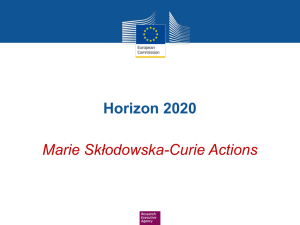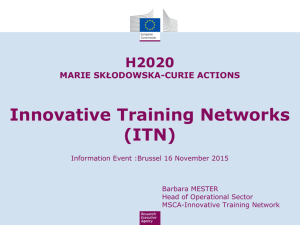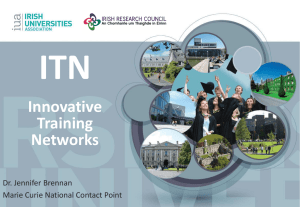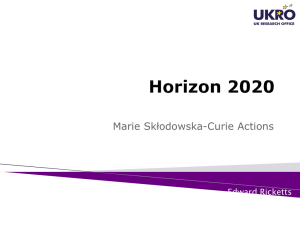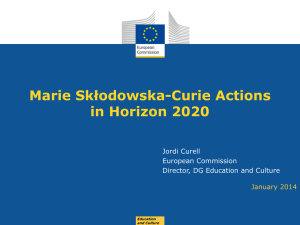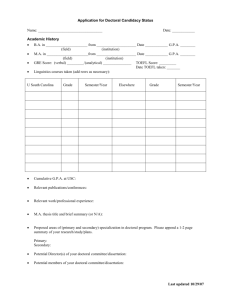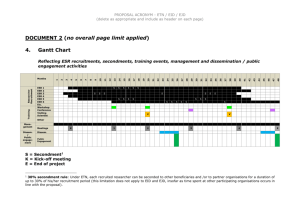non-academic sector
advertisement
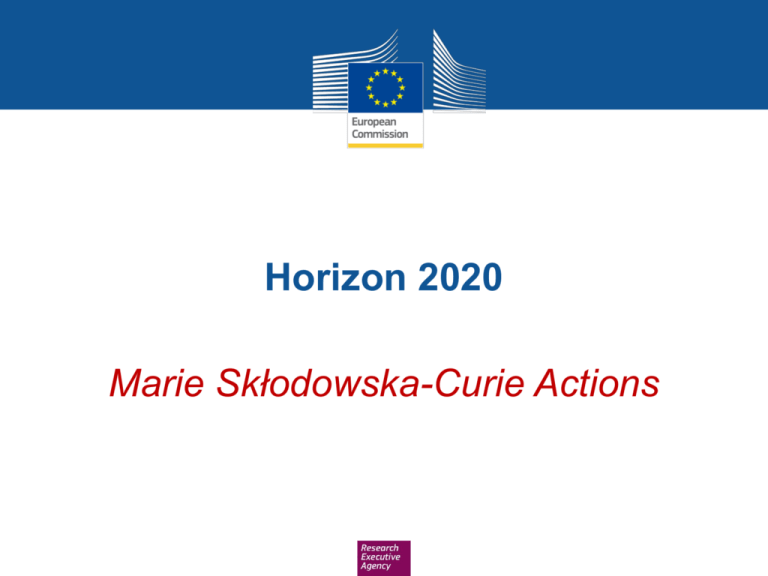
Horizon 2020 Marie Skłodowska-Curie Actions Horizon 2020 MSCA - strategic programming approach Attract and retain research talent Develop state-of-the-art, innovative training schemes, consistent with the highly competitive and increasingly inter-disciplinary requirements of research and innovation Promote sustainable career development in research and innovation Focus on delivering new knowledge and skills, in line with the key driver identified in the strategic programming approach Contribute to a strong partnership with MS via the cofunding mechanism Key features of the MSCA part Open to all domains of research and innovation from basic research up to market take-up and innovation services Entirely bottom-up Participation of non-academic sector strongly encouraged, especially industry and SMEs Mobility as the key requirement - funding on condition participants move from one country to another Promotion of attractive working and employment conditions Particular attention to gender balance Budget 2014/2020 : 6 162 billion € FP7 MCA Achievements • ~80 000 researchers financed since creation of MCA • >10 000 PhD supported in FP7 • ~ 9 200 projects funded so far in FP7 (€4.2 billion) • ~ 17 800 participations of host organisations in 83 countries (46 TC) • ~ 18 500 participations of Marie Curie researchers coming from all over the world: 130 nationalities (90 TC) • 66 000 researcher-months exchanged (~22 000 individuals) in IRSES • SMEs play a major role (IAPP & ITN) • 38% women participation in FP7 MCA (target: 40%) Mobility and eligibility rules Mobility Rules At the time of the relevant deadline for submission of proposals (IF), or recruitment by the host organisation (ITN), researchers shall not have resided or carried out their main activity in the country of their host organisation for more than 12 months in the 3 years immediately prior to the reference date Compulsory national service and/or short stays such as holidays are not taken into account Career Restart Panel, Reintegration Panel and Society and Enterprise in IF: researchers shall not have resided or carried out their main activity in the country of their host organisation for more than 3 years in the 5 years immediately prior to the relevant deadline for submission of proposals Researchers Early Stage Researchers Shall at the time of recruitment (ITN, COFUND) or secondment (RISE), be in the first four years (full-time equivalent) of their research careers and have not yet been awarded a doctoral degree Experienced Researchers Shall, at the time of the relevant deadline for submission of proposals (IF), recruitment (COFUND) or secondment (RISE), be in possession of a doctoral degree or have at least four years of full-time equivalent research experience Nationality, residence Global fellowships and Reintegration panel in IF are open to nationals or longterm residents of EU Member States and Associated Countries. Long-term residence means a period of full-time research activity of at least 5 consecutive years Who applies? International networks of organisations actively involved in research/doctoral training Two categories of organisations Academic sector public /private higher education establishments awarding academic degrees public /private non-profit research organisations whose primary mission is to pursue research international European interest organisations (e.g. CERN, EMBL) Non-academic sector any entity not included in the academic sector: e.g. large companies, SMEs, NGOs, museums, hospitals international organisations (e.g. UN, WHO) Standardised legal validation of entities is applied to determine the domain of each participant ITN : Innovative Training Networks Support for early-stage/doctoral research training through: • European Training Networks (ETN) • European Industrial Doctorates (EID) • European Joint Doctorates (EJD) ITN Objectives • Train innovative early-stage researchers • Excellence in doctoral/early-stage research training • Provide skills to match public and private sector needs ITN Expected impact • Improved career perspectives of researchers • Structured high-quality research / doctoral training • Collaboration academia with non-academic sectors ITN Features (1) Excellence: International network of organisations applies and proposes a joint research training or doctoral programme Bottom-up (no pre-defined topics) All domains*: CHE, ECO, ENG, ENV, LIF, MAT, PHY, SOC Multidisciplinary approach Meaningful exposure to non-academic sector *: except areas of research covered by the EURATOM Treaty ITN typical activities • Core activity: Training through individual research projects • Network-wide training activities (e.g. seminars, workshops, summer schools). • Training in key transferable skills (e.g. entrepreneurship, management, IPR, communication, ethics, grant writing). • Collaboration and exchange of knowledge within the network • Communication & Dissemination • Public engagement Which roles? Beneficiary vs. Signs Grant Agreement Recruits and Hosts Researchers Trains/Hosts Researchers on secondment Participates in Supervisory Board Directly Claims Costs EU funding Partner Organisation Who can be recruited? Researcher-months requested in proposal Recruitment after the project starts. Only Early-Stage Researchers (ESRs): ≤ 4 years of research experience no PhD yet Recruitment: 3 to 36 months (typical) Mandatory trans-national mobility at the time of recruitment. ITN three implementation modes ETN EID EJD European Training Networks European Industrial Doctorates European Joint Doctorates Participants implement a joint research programme 317 M€ Doctoral programme with the non-academic sector Doctoral programme to deliver joint degrees 25 M€ Research fields chosen freely by applicants (CHE, ECO, ENG, ENV, LIF, MAT, PHY, SOC) 28 M€ Eligibility rules? EU 28 Member States (MS) Associated Countries (AC) Other Third Countries (OTC) ETN Min. 3 beneficiaries from any sector from 3 different MS/AC EID Min. 2 beneficiaries from 2 different MS/AC: min. 1 from academic sector + min. 1 from non-academic sector EJD Min. 3 beneficiaries from academic sector awarding PhD from 3 different MS/AC Above this minimum: participants from any sector / country ETN Participants implement a joint research training programme Beneficiaries Partner organisations Doctoral training with the non-academic sector EID ≥ 50% time for each ESR Beneficiaries non-academic sector 2 beneficiaries : max 180 PM Partner organisations Doctoral training with the non-academic sector EID ≥ 50% time for each ESR Beneficiaries Partner organisations non-academic sector ≥3 beneficiaries: max 540 PM EJD Joint PhD Joint PhD Joint PhD Beneficiaries Partner Organisations Beneficiaries Person-months ETN EID EJD ≥3 from 3 diff. MS/AC Any type ≥2 from 2 diff. MS/AC: (≥1 acad + ≥1 non-academic) ≥3 (acad. award PhD) from 3 diff. MS/AC Max. 540 Max. 180 / 540 Max. 540 Researchers Partner Organ. ESRs only (3-36 months) Not pre-defined (any country / sector / discipline) PhD enrolment typically expected mandatory mandatory Non-academic participation essential mandatory essential possible through secondments ≥50% in non-academic possible through secondments 8 panels: CHE, ECO, ENG, EID panel (25 M€) EJD panel (28 M€) Inter-sectoral exposure Panels and rank lists ENV, LIF, MAT, PHY, SOC (317 M€) Innovative Training Networks (ITN) Unit costs/1 researcher month: Marie Skłodowska Curie Actions Innovative Training Networks Researcher unit cost [person/month] Institutional unit cost [person/month] Living allowance Mobility allowance Family Allowance Research, training and networking costs Management and indirect costs 3 110 600 500 1 800 1 200 • Country correction coefficient applies to the living allowance • Researcher allowances include employer contributions. • Researcher allowances are a minimum to be paid (top-up funds from other sources permitted). ITN 2016: H2020-MSCA-ITN-2016 Opened 15 October 2015 Closure: 12 January 2016 (17:00:00 Brussels time) Budget: € 370 Million (ETN: 317 M€, EID: 25 M€; EJD: 28 M€) Results of the evaluation: 5 months after the call deadline Signing of grant agreements: 8 months after the call deadline Results ITN 2014: Submitted & A-list proposals selection Success rate ETN EID EJD 9,4% 18,8% 15,4% ITN 2015: Submitted & A-list proposals Success rate ETN EID EJD 6,3% 9,6% 9,2% Total 6,8% 2015 Results 2015 Thresholds ITN 2015: Eligible and A-list proposals by panel Note: ETN, EJD and EID 2015 ITN 2015: Number of beneficiaries in A-list & Role ITN 2015: Number of beneficiaries in A-list & Mode ETN 783 EID 59 EJD 36 ITN 2015: Number of partner organisations A-list & Mode EID 37 EJD 78 ETN 475 Total 590 ITN 2015 - Number of EID beneficiaries & Role ITN 2015 - Number of EJD beneficiaries & Role Environment LIFE ENG SOC ENV ITN 2015: European Joint Doctorate Programmes in Europe RISE Research and Innovation Staff Exchange Scope: RISE - Promote international and inter-sector collaboration through research and innovation staff exchanges - Sharing of knowledge and ideas for the advancement of science and the development of innovation. - Support is provided for the development of partnerships (e.g. joint research and innovation activities) - Bottom-up approach: set of clear research and innovation objectives and deliverables. General Aspects - All Countries can participate in RISE - All nationalities can participate in RISE - All institutions fulfilling the requirements of the Horizon 2020 Rules for Participation can participate in RISE - No mobility rules* for RISE Project Main Aspects - Project built on joint research and innovation activities - Project implemented through the secondment of staff (no recruitments) - Each staff member seconded for a period of 1 to 12 months - The maximum size for a project is 540 person months - No minimum size explicitly defined for the project, but substantial impact is expected - Maximum project duration is 4 years Participants in RISE - Beneficiaries • Sign the Grant Agreement and claim costs • Are responsible for the execution of the programme • Are established in a MS/AC - Partner Organisations • Do not sign the Grant Agreement and do not claim costs • Must include a letter of commitment in the proposal • Are established in a TC Staff Members - Actively engaged in or linked to research/innovation activities for at least 6 months prior to first secondment - Types of staff members: • • • • ESR (no PhD and < 4 years experience) ER (PhD or > 4 years experience) Managerial staff Administrative or Technical staff - In-built return mechanism Minimum Eligibility Conditions - At least 3 independent participants in 3 different countries - At least 2 participants from 2 different MS/AC - If all in MS/AC: at least 1 academic and 1 non-academic In practice, 2 possible minimum settings: MS/AC 1 + MS/AC 2 + TC or MS/AC 1 Academic + MS/AC 2 Non-Academic + MS/AC 3 Countries Eligible For EU Funding - EU Member States - Overseas Countries and Territories linked to the MS (As defined on page 3 of General Annex A to the Horizon 2020 Work Programme 2014-2015) - Horizon 2020 Associated Countries (In principle, the same as FP7, but subject to the adoption of the association agreements) - The Third Countries listed (On page 3 of General Annex A to the Horizon 2020 Work Programme 2014-2015) EU Contribution Unit costs per researcher per month For secondments eligible for funding Staff member unit cost * Marie Skłodowska-Curie Institutional unit cost * person/month person/month Action Top-up allowance Research and Innovation Staff Exchange 2 000 Research, training and Management networking costs and indirect costs 1 800 *These unit costs are subject to a funding rate of 100% and no country coefficients apply. 700 Next RISE Call Next call: - H2020-MSCA-RISE-2016 - Opens 8 December 2015 - Deadline: 28 April 2016 - Budget: € 80 Million Results of the evaluation: 5 months after the call deadline Signing of grant agreements: 8 months after the call deadline RISE 2015: Submission All-time popularity record with 363 proposals received Increase of 79% compared to RISE 2014 (+160 proposals) Total CHE ECO ENG ENV LIF MAT PHY SOC Total 37 17 114 51 52 11 41 40 363 % 10% 5% 31% 14% 14% 3% 11% 11% 100% Success rates IF : Individual Fellowships Individual Fellowships (IF) Objectives to enhance the creative and innovative potential of experienced researchers to provide opportunities to acquire new knowledge, resume a career or return to Europe the beneficiary shall be a participant established in EU (MS/AC) and employing the researcher during the project Scope Trans-national fellowships awarded to the best or most promising researchers European Fellowships (12-24 months) or Global Fellowships (12-24 months + mandatory return phase of 12 months) Career Restart Panel, Reintegration Panel and Society and Enterprise Panel Secondments, notably in the non-academic sector Expected Impact to release the full potential of researchers and development of their careers in both the academic and non-academic sectors European Fellowships (EF) One (experienced researcher) applies jointly with one host institution located in a MS or AC for a reserach project that can last between 12 and 24 months European Fellowships (EF) Standard European fellowship Career Reintegration Society and Enterprise Project Secondments Global Fellowships Global Fellowships Global Fellowships IF Budget CALL Call 2016 Publication date: 12 April 2016 Deadline(s): 14 September 2016 at 17.00.00 Brussels time Indicative budget: 218.5 M€ 29 M€ are allocated to Global Fellowships 10 M€ are allocated to Society and Enterprise IF 2014: Submitted (eligible) & A-list proposals Withdrawals Ineligible Inadmissible ST CAR RI EF GF Total 7 2 0 16 5 7 5 2 0 9 1 10 28 9 37 7 8 15 Education and Culture Education and Culture Education and Culture COFUND COFUND Objective to stimulate regional, national or international programmes to foster excellence in researchers' training, mobility and career development Scope Co-funding new or existing regional, national, and international programmes to open up to, and provide for, international, intersectoral and interdicisplinary research training, as well as transnational and cross-sector mobility of researchers at all stages of their career Possibilities of synergies with structural funds Doctoral Programmes (for ESR) and Fellowship Programmes (for ER) Researchers to comply with the mobility rules of the MSCA Minimum support for researchers: 3 months Implemented by a sole beneficiary Expected Impact to exploit synergies between European Union actions and those at regional, national, and international level, and leverage funding COFUND COFUND Doctoral Programmes Training follows the EU Principles on Innovative Doctoral Training. Collaboration with a wider set of partners, including from the non-academic sector, which may provide hosting or secondment opportunities or training Fellowships Programmes Regular selection rounds following fixed deadlines or regular cut-off dates allowing a fair competition between applying researchers. The selections should be based on open, widely advertised competition, with transparent international peer review and selection of candidates on merits. Mobility types may be similar to the ones supported under Marie Skłodowska-Curie. Limitations regarding the researchers' origin and destination should be avoided Proposed programmes are encouraged to cover all research disciplines COFUND Marie Skłodowska Curie Actions Research unit cost [person/month]*** Early-stage researchers 3 710 Experienced researchers 5 250 COFUND Institutional unit cost [person/month] 650 *** These unit costs will be subject to a co-funding rate of 50% COFUND Call 2016 Publication date: 14 April 2016 Deadline(s): 29 September 2016 at 17.00.00 Brussels time Indicative budget: 80 M€: 30 M€ are allocated to Doctoral Programmes. Contribution has maximum overall of 10 M€ to a single applicant Duration: 36 to 60 months. This duration includes also the time that is needed to select or recruit the researchers Participants having benefited from COFUND under previous calls will explain how the latest proposal relates to and goes beyond the earlier grant and provide evidence for its quality Submission of the proposal Where to find information? Participant Portal Call pages Guide for Applicants Work Programme (2016-17) FAQ Descriptors Contacts and useful documents The Europe grant office of the host institution The national contact point : Advice; meetings, trainings but not proof-reading Work programes 2016/2017 Guide for applicants and templates of the year of the call European policies EU principles for innovative training networks : http://ec.europa.eu/euraxess/pdf/research_policies/Principl es_for_Innovative_Doctoral_Training.pdf Participant portal Go to the participant portal at the link : http://ec.europa.eu/researc h/participants/portal/deskto p/en/opportunities/h2020/in dex.html The right call Submission service Authentification service Ensure you have your ECAS account and the PIC number of the host institution (beneficiary) PROPOSITION TEMPLATE Structure of proposals Part B - description of action - Part A - structured data - (Beneficiaries) (Partner organisations) Part A This part is filled online General information : title, acronym of the project, abstract (2000 characters max) Panels, descriptors and key words will guide the REA in the selection of experts for proposal evaluations Data of participating organisations : the PIC (Participant Identification Code) is the one of the beneficiary The budget will be calculated automatically Ethics issues table Validate your data, and « Save and close » Part B Page Limits • Clearly indicated in Guide for Applicants • Excess pages to be disregarded in evaluation ……. pages max BUDGET EU Contributions / Amounts EVALUATION CRITERIA Award criteria o Excellence : 50% o Impact : 30% o Implementation : 20% Education and Culture Award criteria: Key features Evaluation scores will be awarded for each of the criteria, not for their individual elements Each criterion scored from 0 to 5 - decimal points will be given: o 0 - The proposal fails to address the criterion under examination or cannot be judged due to missing or incomplete information o 1 - Poor. The criterion is addressed in an inadequate manner, or there are serious inherent weaknesses. o 2 - Fair. While the proposal broadly addresses the criterion, there are significant weaknesses. o 3 - Good. The proposal addresses the criterion well, although improvements would be necessary. o 4 - Very good. The proposal addresses the criterion very well, although certain improvements are still possible. o 5 - Excellent. The proposal successfully addresses all relevant aspects of the criterion in question. Any shortcomings are minor. Total score subject to a threshold of 70% Education and Culture ITN Example EXCELLENCE Quality, innovative aspects and credibility of the research programme (including inter/multidisciplinary and intersectoral aspects) Quality and innovative aspects of the training programme (including transferable skills, inter/multidisciplinary and intersectoral aspects) Quality of the supervision (including mandatory joint supervision for EID and EJD projects) Quality of the proposed interaction between the participating organisations IMPACT Enhancing research- and innovation-related human resources, skills, and working conditions to realise the potential of individuals and to provide new career perspectives Contribution to structuring doctoral/early-stage research training at the European level and to strengthening European innovation capacity, including the potential for: a) meaningful contribution of the non-academic sector to the doctoral/research training, as appropriate to the implementation mode and research field b) developing sustainable joint doctoral degree structures (for EJD projects only) Effectiveness of the proposed measures for communication and dissemination of results IMPLEMENTATION Overall coherence and effectiveness of the work plan, including appropriateness of the allocation of tasks and resources (including awarding of the doctoral degrees for EID and EJD projects) Appropriateness of the management structures and procedures, including quality management and risk management (with a mandatory joint governing structure for EID and EJD projects) Appropriateness of the infrastructure of the participating organisations Competences, experience and complementarity of the participating organisations and their commitment to the programme EVALUATION PROCESS Panels Proposals are allocated to one of the eight main evaluation panels: Chemistry (CHE) Social Sciences and Humanities (SOC) Economic Sciences (ECO) Information Science and Engineering (ENG) Environment and Geosciences (ENV) Life Sciences (LIF) Mathematics (MAT) Physics (PHY) o o o In ITN, separate multidisciplinary panels will be created for EID and the EJD In IF, separate multidisciplinary panels will be created for the Career Restart Panel (CAR), the Reintegration Panel, and the Society and Enterprise Panel. COFUND evaluation will be organised in two different panels: Doctoral programmes and Fellowship programmes. Education and Culture Evaluation procedure For each panel a ranked list is established The distribution of the budget of the call will be proportional to the number of eligible proposals received in each panel, except where a specific budget for a multidisciplinary panel has been fixed in the call. Excess budget will be reallocated to the other panels Proposals will not be evaluated anonymously. A panel review will recommend one or more ranked lists for the proposals Priority order for proposals which have been awarded the same score If necessary, any further prioritisation will be based on other appropriate characteristics, to be decided by the panel Education and Culture 3 Individual Assessments Consensus Ranked list Proposal A Proposal B B>A>C Proposal C Remote Central Evaluation Summary Report Education and Culture Reminders Experts will evaluate proposals as submitted (not on its potential if certain changes were to be made) Proposals selected for funding are converted into description of work of the grant agreement. Commitment Letters and recommendation letters No reference to the outcome of previous evaluations in part B Ethics (part A and part B) RECOMMENDATIONS Recommendations : the project 1 - Choose the right call, the right area, consult NCP (eligibility) 2 - Respect conditions (participants, full time, budget, etc.) 3 - Show european dimension (scale, populations, cooperations) 4 - Develop perspectives (synergies, future…) 5 - Choose the right duration of your project in line with the objectives 6 - Have a strong partnership (host/you), complementarity, time 7 - Plan research and Training 8 - Have a workprogramme : use Gantt chart 9 - Mention interdisciplinarity, intersectorality 10 - Describe carefully the methodology (advantages/difficulties) 11 - State of the art should be accurate 12 - Choose a problem-solving approach 13 - Choose clear and measurable objectives 14 - Insist on the innovative part of your project Recommendations : researcher 15 16 17 18 19 - Plan research and Training : show the training capacities Argue about your career (leadership, maturity…) Choose an effective mobility (genuine) Underline your major publications Underline the perfect appropriatness of your profil and the project Recommendations : training 20 - Integrate training about equipments, new tools, new softwares 21 - Take part in internal seminars, workshops, summer schools, … 22 - Participate to dissemination of scientific culture 23 - How to answer research calls 24 - Financial training + management 25 - Complementarity skills (communication, Intellectual property, management…) 26 - Intersectoral (public/private) relation, employability 27 - Launch new collaborations Recommendations : host laboratory 28 - Choose a well known laboratory, with a good reputation 29 - Choose a well known supervisor 30 - Choose an institution with a high level of quality 31 - Underline the main achievement of your host laboratory (patents, publications, number of PhD, contracts, international projects…) 32 - Describe carefully the infrastructure/equipments… Recommendations : implementation 33 - Wait 6 months before to start 34 - Describe responsabilities (who do what) 35 - Anticipate resolution of conflicts, organise communication (meetings) 36 - Organise your budget (even with flat rate) : 37 - Resources : environment, infrastructures 38 - Expenses : summer schools, conferences, consumables 39 - Describe host institution (library, equipments, C&C…) 40 - Describe type of contract (justify stipend) Recommendations : impact 41 42 43 44 (ex: 45 (ex: 46 - Interest of your mobility (for you, for the lab, etc.) Describe synergies (societal challenges) Describe the European “added value” Link your research with European policies green papers, recommendations…) Propose outreach activities Science week, researchers night) Propose links with students, with medias Recommendations : writing 47 - Respect the number of pages for each part 48 - Write in English and in good English (concision, accuracy) 49 - Take care of the format (diagrams, tables, bold…) 50 - Avoid redundancies 51 - Give easy access to the information (numbers, tables, references…) 52 - Read all documents : guides, guidelines for evaluators… 53 - Write with the help of the supervisor and host institution 54 - Take time for Abstract and keywords Think as if you were the evaluator (3 persons, interdisciplinarity/intersectoriality of the panel…) 55 - Evaluators are from all over Europe and beyond (Forget national codes) 56 - Take care of the criteria, weighting, threshold, success rates… 57 - Give your proposal to read 58 - Find an accepted project http://www.horizon2020.gouv.fr/cid79134/boite-outils-pour-les-actionsmarie-sklodowska-curie.html Other initiatives : Euraxess Success stories Education and Culture pcn-mariescurie@recherche.gouv.fr
